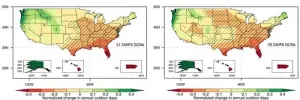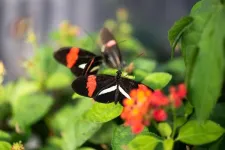New generation estrogen receptor-targeted agents in breast cancer
2024-03-21
(Press-News.org) https://www.scienceopen.com/hosted-document?doi=10.15212/AMM-2024-0006
Announcing a new publication for Acta Materia Medica journal. Endocrine therapy that blocks estrogen receptor signaling has been effective for decades as a primary treatment choice for breast cancer patients expressing the estrogen receptor. However, the issue of drug resistance poses a significant clinical challenge. It is therefore critically important to create new therapeutic agents that can suppress ERα activity, particularly in cases of ESR1 mutations. This review article highlights recent efforts in drug development of next generation ER-targeted agents, including oral selective ER degraders, proteolysis-targeting chimera ER degraders, and other innovative molecules, such as complete estrogen receptor antagonists and selective estrogen receptor covalent antagonists. The drug design, efficacy, and clinical trials for each compound are detailed.
# # # # # #
Acta Materia Medica welcomes the submission of research articles, review articles, databases, mini reviews, commentaries, editorials, short communications, case report articles and study protocols.
Submission Process
Submissions to Acta Materia Medica are made using ScholarOne, the online submission and peer review system. Registration and access are available at https://mc04.manuscriptcentral.com/ammed
Queries about the journal can be sent to editorialoffice@amm-journal.org.
Please visit https://amm-journal.org/ to learn more about the journal.
Editorial Board: https://amm-journal.org/index.php/editorial-board/
There are no author submission or article processing fees.
Follow Acta Materia Medica on Twitter https://twitter.com/AMM_journal; Facebook (https://www.facebook.com/AMMjournal)
eISSN 2737-7946
# # # # # #
Jian Min, Xin Liu and Rouming Peng et al. New generation estrogen receptor-targeted agents in breast cancer: present situation and future prospectives. Acta Materia Medica. 2024. Vol. 3(1):57-71. DOI: 10.15212/AMM-2024-0006
END
ELSE PRESS RELEASES FROM THIS DATE:
2024-03-21
For most people, reading about the difference between a global average temperature rise of 1.5 C versus 2 C doesn’t conjure up a clear image of how their daily lives will actually be affected. So, researchers at MIT have come up with a different way of measuring and describing what global climate change patterns, in specific regions around the world, will mean for people’s daily activities and their quality of life.
The new measure, called “outdoor days,” describes the number of days per year that outdoor temperatures are neither too ...
2024-03-21
A collaboration between scientists from St. Jude Children’s Research Hospital and Dana-Farber Cancer Institute uncovered four proteins that govern the identity of anaplastic large cell lymphoma (ALCL), an aggressive form of cancer. These proteins comprise a core regulatory circuit (CRC) that surprisingly incorporates a dysregulated signaling protein. Establishing the CRC for this lymphoma gives researchers insight into potential vulnerabilities that may be future therapeutic targets. The findings were published today in Cell Reports Medicine.
“Mutations in signaling pathways have long been known to drive oncogenic transformation ...
2024-03-21
Expanding organic cropland can lead to increased pesticide use in surrounding conventional fields while reducing pesticide use on nearby organic fields, according to a study based in a leading U.S. crop-producing region. The findings provide insight into overlooked environmental impacts of organic agriculture and suggest that clustering organic fields could reduce pesticide use at the landscape scale. Organic agricultural practices are designed to have less negative local environmental impacts than other forms of intensive agriculture. However, the ...
2024-03-21
A particular gene plays a critical role in visual preference for mate choice between closely related Heliconius butterflies, according to a new study. The findings provide insight into how visually guided behaviors can be encoded within the genome. Many species use color and other visual cues to attract and recognize suitable mates. As such, visual preferences are important drivers of mate choice and sexual selection. However, while the genetics and evolution of the traits that serve as these cues – such as butterfly wing color – are ...
2024-03-21
Constructing human artificial chromosomes (HACs) in budding yeast overcomes the long-standing problem of uncontrolled multimerization – the rampant joining of similar molecules – and results in HACs that are large, stable, and structurally well-defined, researchers report. The findings may help advance chromosome engineering for precise genome editing in mammals and many other organisms. Artificial chromosomes can carry large numbers of engineered genes. Their use in bacteria and yeast as vehicles for writing and rewriting genomes has hinted at their potential to provide an alternative approach to editing genetic material in human cell lines. Although the first HACs were ...
2024-03-21
In a Policy Forum, Alan Schoenfeld and Phil Daro argue that the “equity versus excellence” controversy over how mathematics is taught has long disrupted education in the United States, particularly for underrepresented ethnic and socioeconomic groups. According to Schoenfeld and Daro, K-12 mathematics education in the U.S. is structured in ways that are problematic and do not reflect international trends. For more than 50 years, the typical yet rigid sequence of hierarchical mathematics courses – algebra 1 to geometry to algebra II to precalculus to calculus – has disenfranchised ...
2024-03-21
Tropical Heliconius butterflies are well known for the bright colour patterns on their wings. These striking colour patterns not only scare off predators – the butterflies are poisonous and are distasteful to birds – but are also important signals during mate selection. A team led by evolutionary biologist Richard Merrill from LMU Munich, in cooperation with researchers from the Universidad del Rosario in Bogotá (Colombia) and the Smithsonian Tropical Research Institute (Panama), has now exploited the diversity of warning patterns of various Heliconius species to investigate the genetic foundations of these preferences. ...
2024-03-21
When you are reading this article, there are multiple hormones working diligently inside your body to stabilize your health status. Same as human beings, it is impossible for plants to grow and reproduce without being regulated by phytohormones. One of the phytohormones is the Brassinosteroid (BR) hormones, also named as the sixth phytohormone.
According to a study published in Science on March 22, 2024, researchers led by Prof. SUN Linfeng from the Division of Life Sciences and Medicine of the University of Science and Technology ...
2024-03-21
Images
A new way to make an important ingredient for plastics, adhesives, carpet fibers, household cleaners and more from natural gas could reduce manufacturing costs in a post-petroleum economy by millions of dollars, thanks to a new chemical reactor designed by University of Michigan engineers.
The reactor creates propylene, a workhorse chemical that is also used to make a long list of industrial chemicals, including ingredients for nitrile rubber found in automotive hoses and seals as well as blue protective gloves. ...
2024-03-21
How does your brain know the position and movement of your different body parts? The sense is known as proprioception, and it is something like a “sixth sense”, allowing us to move freely without constantly watching our limbs.
Proprioception involves a complex network of sensors embedded in our muscles that relay information about limb position and movement back to our brain. However, little is known about how the brain puts together the different signals it receives from muscles.
A new study led by Alexander Mathis at EPFL now sheds light on the question by exploring how our brains create a cohesive sense of body position and movement. Published in Cell, ...
LAST 30 PRESS RELEASES:
[Press-News.org] New generation estrogen receptor-targeted agents in breast cancer




